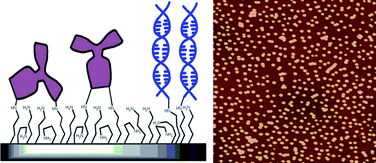High efficiency amine functionalization of cycloolefinpolymer surfaces for biodiagnostics†
Abstract
Point-of-care (

a
Biomedical Diagnostics Institute (BDI), Dublin City University, Collins Avenue, Glasnevin, Dublin, Ireland
E-mail:
ramprasad.gandhiraman@dcu.ie
Fax: +353 1 7006558
Tel: +353 1 7007984
b Research Centre in Physics of Matter and Radiation (PMR), University of Namur (FUNDP), 61, rue de Bruxelles, Namur, Belgium
c Research Centre for Surface and Materials Science, Department of Chemical and Materials Engineering, University of Auckland, Private Bag 92019, Auckland, New Zealand
d Industrial Research Limited, 69 Gracefield Road, P.O. Box 31-310, Lower Hutt, New Zealand
e Stanford Synchrotron Radiation Lightsource, 2575 Sand Hill Road, Menlo Park, California, USA
f National Centre for Plasma Science and Technology, Dublin City University, Collins Avenue, Glasnevin, Dublin, Ireland
g MacDiarmid Institute for Advanced Materials and Nanotechnology, Department of Chemistry, University of Auckland, Private Bag 92019, Auckland, New Zealand
Point-of-care (

 Please wait while we load your content...
Something went wrong. Try again?
Please wait while we load your content...
Something went wrong. Try again?
R. P. Gandhiraman*, C. Volcke, V. Gubala, C. Doyle, L. Basabe-Desmonts, C. Dotzler, M. F. Toney, M. Iacono, R. I. Nooney, S. Daniels, B. James and D. E. Williams, J. Mater. Chem., 2010, 20, 4116 DOI: 10.1039/B925737C
To request permission to reproduce material from this article, please go to the Copyright Clearance Center request page.
If you are an author contributing to an RSC publication, you do not need to request permission provided correct acknowledgement is given.
If you are the author of this article, you do not need to request permission to reproduce figures and diagrams provided correct acknowledgement is given. If you want to reproduce the whole article in a third-party publication (excluding your thesis/dissertation for which permission is not required) please go to the Copyright Clearance Center request page.
Read more about how to correctly acknowledge RSC content.
 Fetching data from CrossRef.
Fetching data from CrossRef.
This may take some time to load.
Loading related content
